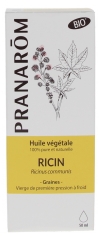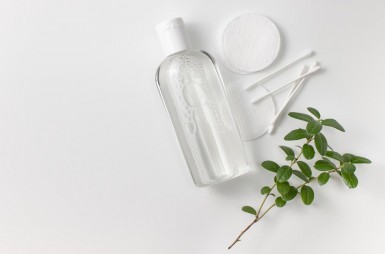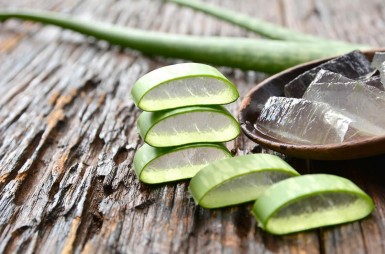Castor oil:
the secret to beautiful hair
Written by Marion, Aesthetician/Cosmetician | published on | updated on 30/03/2020

Having been praised since Antiquity for its numerous benefits, castor oil is still regarded today as an elixir for healthy hair and body. We tell you about its properties and its many uses.
What is castor oil?
Castor oil – which by the way has nothing to do with the well-known rodent – is a very slimy colorless or straw-colored oil. It can be extracted by broiling castor beans, which allows for greater amounts of oil to be collected; yet the process degrades its properties. Although it may be a bit expensive, cold-pressed castor oil is of higher quality and stands as the most efficient version of that natural resource. Castor oil is also used in the chemical industry – it can be found in the composition of polyurethanes, for instance – as well as in refined form in some pharmaceutical products. Even though extracts of that oil are transformed into food additives, it is best when used in a cosmetic approach.
Composition: fatty acids found in castor oil:
- Ricinoleic acid: around 87 %;
- Oleic acid (Omega 9): 3-4 %;
- Linoleic acid (Omega 6): around 5 %;
- Palmitic acid and stearic acid: 1-2 % each.
Where does castor oil come from?
Castor oil grows on a flowering plant (ricinus communis) that belongs to the Euphorbiaceae family. It can be found in its natural state in all of tropical Africa as well as in India, especially in uncultivated soil. In these latitudes, this beautiful tree can reach 32.8 to 39.4 feet. Its green or purple pinnately lobed leaves and its red fruits (capsules) bristling with thorns form a very decorative tree. That explains why it is now so common in Europe and why it can reach 16.4 feet depending on the climate.
For its industrial and cosmetic uses, castor oil is now mainly cultivated in India (at 70 %), as well as in China, Brazil and Africa.
It is worth noting that the whole plant (i.e. foliage and seeds) is highly toxic. Be careful with kids running around if you grow castor oil in your garden. The plant contains a poison called ricin which – when ingested or inhaled – is even more toxic than cyanide. Don’t panic though: castor oil doesn’t contain any ricin and you can thus use it without any problem.
Castor oil: a mole hunter! Did you know that numerous gardeners use castor oil to keep moles away from their vegetable patches? That’s another original use for this multipurpose plant! Moles are really useful ecology-wise except when they turn your beautiful lawn into a bump-filled war zone! Spraying castor oil in burrows is said to work as an efficient repellent. You can also try castor oil cake which is both a nitrogen fertilizer and a repellent.
What are the properties of castor oil?
For internal use, castor oil has always been prescribed as a purgative and as a remedy to relieve constipation. That specific use is no longer recommended without medical advice as it makes for a very potent purgative that can deteriorate the intestinal wall and trigger diarrhea if misused or taken at excessive doses. For external use, castor oil offers wonderful benefits. It definitely should be in all medicine cabinets – yet out of reach of children – for its extraordinary effects on hair, skin and nail.
It is mostly well-known for its ability to make hair grow faster. Castor oil makes hair stronger, shinier and prettier by feeding their roots the fatty acids they need. It also prevents allopecia (hair loss), slows down the appearance of white hair (catinia) and reduces scalp itching and dandruff. While men can use castor oil to get a thicker and softer beard, it can also be applied on eyelashes to accelerate their growth and reinforce them.
When applied to the skin, castor oil greatly enhances its moisturizing, softness and suppleness.
As for fragile and brittle nails, castor oil stands as an efficient remedy that offers both strength and brilliance.
How to use castor oil?
For the hair
- You wish to accelerate the growth of your hair, reduce the dryness of your scalp or get rid of dandruff? In that case, the best way to use castor oil is to blend it with another oil (eg. olive oil) at the same dosage to make it more liquid, before applying it onto the scalp in circular motions. Let it rest for at least twenty minutes, or even a few hours, and rinse it while you’re shampooing. You can follow these steps two to three times a week during a month then stop and resume if you feel like it. We advise to follow the exact same steps for beards!
- You wish to protect your hair, make it suppler and shinier, and delay the appearance of split ends? Apply a mix of castor oil and argan or coconut oil on the lengths then let it rest a few minutes before shampooing your hair.
For the skin
Castor oil offers better moisturization for the skin and fights excess sebum production. It also is nourishing and healing. Apply on clean skin in circular motions then wash it off with lukewarm water and dry gently. You can also mix castor oil with more liquid oils such as apricot oil. If you are prone to fungal skin infections, note that castor oil has antifungal properties.
For the nails
Applying a few drops of castor oil on your nails just before going to bed will make them stronger and will soften the area around the cuticles.
Which castor oil best suits your needs?
Castor oil is to be bought pure or blended with other cosmetic products such as shampoos or masks. If you buy it pure in order to make your own preparations and blends, or to use it in its simple form, it is recommended you get 1st cold-pressed organic castor oil. This will give you optimum quality. Cocooncenter offers numerous castor oil-based products – that either contain pure castor oil or use it as part of a blend – to take care of yourself in a natural way!
Try castor oil for a few weeks and you’ll notice its efficiency. Strong nails, beautiful hair and a nourished skin: you’ll be amazed at the results.
Three key points to remember about castor oil:
- The properties of castor oil plant are real. This oil was already popular in Ancient Egypt and its effects have been resoundingly demonstrated from ancient civilizations to today’s pharmacopoeia.
- Do not ingest castor oil without medical advice. External use is totally harmless.
- As is often the case with beauty treatments, the effects of castor oil on the skin, the nails and the hair depend on the regularity of the applications! The right dose at the right frequency is the secret to enjoy all the benefits.




















